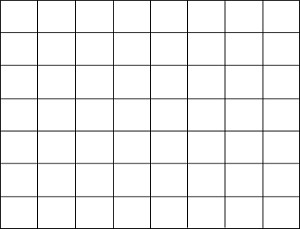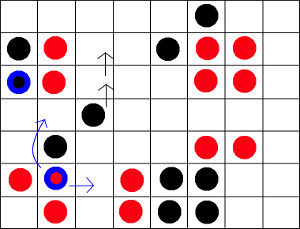
Latrunculi (also called Ludus Latrunculorum) was played in Ancient Rome. It was very similar to Petteia, a game played in Ancient Greece. It's possible that the two were versions of the same game. The name of the game comes from the Latin word for a hired mercenary. It could also indicate a highwayman (Parlett, The Oxford History 235). The oldest known source for this game was Varro, who lived from 116 to 27 BC, although the game most likely existed before his time (Bell, Board and Table Games 84).
The board for this game is a rectangle made up of smaller squares, but it could be different sizes. There have been examples found with different numbers of squares: 7x8, 8x8 (the shape of a standard Chess or Checkers board), or 9x10. According to Ovid, the playing pieces could be made of glass or gemstones (Bell, Board and Table Games 84). The colors and designs of the pieces could also vary. A painting on a wall in Pompeii depicted a game board with white, black, and yellow pieces. White, black, and blue playing pieces were found in an excavation of barracks at Chester dating from the end of the first century (Bell, Board and Table Games 86). Some pieces that have been found have a hole in the middle, and some were decorated with concentric circles. Others were just plainly colored with no other markings (Bell, Board and Table Games 84).
There is no existing complete set of rules from ancient times, but there are several ancient references to the game that describe aspects of it. Scholars have used these references to try to reconstruct the game as it was once played (Parlett, The Oxford History 235-236). From a description in a poem by Saleius Bassus written in the first century A.D., the game sounds similar to Seega (Bell, Board and Table Games 84-85).
Below, I provide rules and a printable board for playing the game at home. You can also play the game for free online here, one player against a computer opponent. This site also offers historical information and an alternate set of rules for the game.
Latrunculi
The rules for this game come from Board and Table Games from Many Civilizations by R.C. Bell, pp. 84-87. For this version of the game, we'll use an 8x7 board, although this game can also be played on a Chess or Checkers board.
Players: 2
Object: To capture the opponent's pieces.
Equipment: The board (printable), two sets of 16 playing pieces in two different colors (black and white are good, but they can be any color except blue, I used red and black so they would show up well in the example) and two blue pieces (one for each player, you may want to mark them in some way or make them different shapes so that you can tell them apart because each player will get one). You can buy colored glass pieces from a craft store for the playing pieces or just cut circles out of colored construction paper.
Set Up: The players begin by deciding which of them will go first and who will play with which set of pieces. Each player should get a set of 16 pieces and one of the two blue pieces. Then, they take turns placing their pieces on the board, two at a time. The players are allowed to put their pieces anywhere they want to on the board. No one makes any captures while the players are placing their pieces on the board. When both players have all sixteen of their pieces on the board, they each place their blue piece on the board. Each blue piece is called a dux.
Tips for Placing Pieces: If you can put pieces anywhere, how do you know where to place them? This game is about two players capturing each other's pieces. When you read the section on capturing pieces, you'll see that it's pieces that are all by themselves with space on each side and pieces that are directly next to enemy pieces without a friendly piece to protect their other side that are in the most danger. When you start out, it's a good idea to place pieces in pairs right next to each other instead of splitting them up so that they can protect each other. The safest formation for pieces to be in is in a square, at least two pieces by two pieces because none of them can be surrounded. However, it is smart to have at least some of your pieces sitting next to enemy pieces because it will help you to make captures later. You may want to make a series of little square formations in different sections of the board. (Bell doesn't discuss this strategy. This is something I worked out myself. If you come up with a different strategy that is more effective, let me know.)
Moving Pieces: Once all of the pieces, including the dux, are on the board, the players can begin to move their pieces. They take turns moving one piece at a time, and each piece can be moved only one space at a time. They can move forward, backward, or sideways, but not diagonally.
A dux can move like the other pieces (one space, either forward, backward, or sideways), but it also has the option to jump over enemy pieces, landing on the square immediately on the other side (the blue arrows in the picture below show possible moves for the dux). While jumping, it still moves in a straight line, not diagonally. The dux cannot move and jump on the same turn; it's a choice of one or the other. The piece it jumps over isn't captured, but you can use this maneuver to set up a capture.

Capturing: Players capture each other's pieces by catching them between two of their own pieces. A player can only capture one of his opponent's pieces at a time by moving his pieces to flank the opponent's piece. While a player can protect a piece by having it next to another friendly piece, if the opponent can still manage to get one of his pieces on either side of it in another direction, he can still take it. (That's why pieces in a square formation are safe, because they are protected on multiple sides. As you see in the drawing, the black piece whose movement is show by the black arrows has a way of capturing the red pieces above and to the left of it. Their right sides are vulnerable. It would be different if he tried to attack from above and below. They are protected there. You can't flank two pieces at the same time.)
However, when a player captures a piece, his turn doesn't end immediately: he is allowed to move the piece he just moved in order to make the capture one more time (one space either forward, backward, or sideways, as usual). If he can move it to a place where he can make another capture, he does so, and he gets yet another move with the same piece. A player can make a series of captures like this (as shown by the black arrows in the picture). His turn ends when he can no longer make a capture using the piece he is currently moving.
The dux can make captures just like the other pieces. It can also use its jumps to make captures if it lands on a space next to an enemy piece that already has a friendly piece on the other side. Like other pieces, it can also make a series of captures, either by moving normally or by jumping or some of each. However, the dux can also be captured, like any other piece.
It is important to note that a player may deliberately move a piece between two enemy pieces without having it captured. A piece can only be captured if the player capturing it moves one of his pieces to do it.
Winning: The winner is the player who captures all of the other player's pieces. The game can also end if the players create a blockade against each other that they can't break. If no one has made a capture in the last thirty moves, the players have effectively blockaded each other. In that case, the winner is the player who has the most pieces still on the board.

